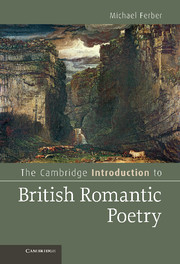Book contents
- Frontmatter
- Contents
- Preface
- Acknowledgments
- Chapter 1 Introduction
- Chapter 2 The poet
- Chapter 3 “Tintern Abbey”
- Chapter 4 Romantic odes
- Chapter 5 The French Revolution
- Chapter 6 Romantic sonnets
- Chapter 7 Romantic love lyrics
- Chapter 8 Romantic ballads
- Chapter 9 Romantic epics and romances
- Chapter 10 Romantic verse drama
- Chapter 11 Romantic satire
- Appendix
- Notes
- Further reading
- Index
Chapter 7 - Romantic love lyrics
Published online by Cambridge University Press: 05 June 2012
- Frontmatter
- Contents
- Preface
- Acknowledgments
- Chapter 1 Introduction
- Chapter 2 The poet
- Chapter 3 “Tintern Abbey”
- Chapter 4 Romantic odes
- Chapter 5 The French Revolution
- Chapter 6 Romantic sonnets
- Chapter 7 Romantic love lyrics
- Chapter 8 Romantic ballads
- Chapter 9 Romantic epics and romances
- Chapter 10 Romantic verse drama
- Chapter 11 Romantic satire
- Appendix
- Notes
- Further reading
- Index
Summary
A large share of Romantic lyric poetry, and a large share of the best of it, does not fall under such well-defined categories as “sonnet” or even the looser genre called “ode.” Wordsworth and Coleridge, as we saw, wrote poems of various lengths called “Lines” (usually with a descriptive subtitle), Coleridge wrote “Monodies,” Shelley wrote “Stanzas,” several poets wrote deliberate fragments, and so on. Many Romantic poems were called “songs” and were even set to music, but songs come in many shapes and sizes. Some poems are very short – a couplet or quatrain – while others, such as Coleridge’s “conversation” poems or Wordsworth’s “Tintern Abbey,” are fairly long. They may or may not come grouped into stanzas or graced with rhyme. The main reason we call all of them “lyric” is merely genealogical, as we trace their ancestry back to songs sung by Greeks to the lyre, and that fact is of little help in categorizing them in 1800 or today. A good handbook of literary terms defines “lyric” as “A brief subjective poem strongly marked by imagination, melody, and emotion, and creating a single, unified impression.” I have no better definition to offer, and yet I have sometimes come across poems that I would like to call “lyric” but that do not strike me as very imaginative, melodious, emotional, or even subjective. It might be simpler, then, to retain “lyric” as the residual category after we separate out narrative and dramatic verse, which are more readily defined, or to enumerate its subgenres with a miscellaneous addendum: “lyric poems include odes, sonnets, and the like.” Neither approach is very satisfactory, but they needn’t trouble us as long as we have a rough idea of what we are talking about.
- Type
- Chapter
- Information
- The Cambridge Introduction to British Romantic Poetry , pp. 130 - 145Publisher: Cambridge University PressPrint publication year: 2012

